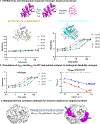Functional roles of enzyme dynamics in accelerating active site chemistry: Emerging techniques and changing concepts
- PMID: 35872562
- PMCID: PMC9901422
- DOI: 10.1016/j.sbi.2022.102434
Functional roles of enzyme dynamics in accelerating active site chemistry: Emerging techniques and changing concepts
Abstract
With the growing acceptance of the contribution of protein conformational ensembles to enzyme catalysis and regulation, research in the field of protein dynamics has shifted toward an understanding of the atomistic properties of protein dynamical networks and the mechanisms and time scales that control such behavior. A full description of an enzymatic reaction coordinate is expected to extend beyond the active site and include site-specific networks that communicate with the protein/water interface. Advances in experimental tools for the spatial resolution of thermal activation pathways are being complemented by biophysical methods for visualizing dynamics in real time. An emerging multidimensional model integrates the impacts of bound substrate/effector on the distribution of protein substates that are in rapid equilibration near room temperature with reaction-specific protein embedded heat transfer conduits.
Copyright © 2022 Elsevier Ltd. All rights reserved.
Conflict of interest statement
Conflict of interest None declared.
Figures



Similar articles
-
A Biophysical Perspective on Enzyme Catalysis.Biochemistry. 2019 Feb 12;58(6):438-449. doi: 10.1021/acs.biochem.8b01004. Epub 2018 Dec 18. Biochemistry. 2019. PMID: 30507164 Free PMC article.
-
The dynamical nature of enzymatic catalysis.Acc Chem Res. 2015 Feb 17;48(2):407-13. doi: 10.1021/ar5002928. Epub 2014 Dec 24. Acc Chem Res. 2015. PMID: 25539144 Free PMC article.
-
Protein conformational populations and functionally relevant substates.Acc Chem Res. 2014 Jan 21;47(1):149-56. doi: 10.1021/ar400084s. Epub 2013 Aug 29. Acc Chem Res. 2014. PMID: 23988159 Review.
-
Electron transfer kinetics in photosynthetic reaction centers embedded in trehalose glasses: trapping of conformational substates at room temperature.Biophys J. 2002 Feb;82(2):558-68. doi: 10.1016/S0006-3495(02)75421-0. Biophys J. 2002. PMID: 11806901 Free PMC article.
-
Dynamically achieved active site precision in enzyme catalysis.Acc Chem Res. 2015 Feb 17;48(2):449-56. doi: 10.1021/ar5003347. Epub 2014 Dec 24. Acc Chem Res. 2015. PMID: 25539048 Free PMC article. Review.
Cited by
-
Engineering the Active Site Lid Dynamics to Improve the Catalytic Efficiency of Yeast Cytosine Deaminase.Int J Mol Sci. 2023 Apr 1;24(7):6592. doi: 10.3390/ijms24076592. Int J Mol Sci. 2023. PMID: 37047565 Free PMC article.
-
3D variability analysis reveals a hidden conformational change controlling ammonia transport in human asparagine synthetase.Nat Commun. 2024 Dec 3;15(1):10538. doi: 10.1038/s41467-024-54912-9. Nat Commun. 2024. PMID: 39627226 Free PMC article.
-
Anisotropic dynamics of an interfacial enzyme active site observed using tethered substrate analogs and ultrafast 2D IR spectroscopy.J Chem Phys. 2023 Oct 28;159(16):165101. doi: 10.1063/5.0167991. J Chem Phys. 2023. PMID: 37870142 Free PMC article.
-
Enzyme dynamics-a brief review.Biophys Rev. 2023 Jun 23;15(3):317-320. doi: 10.1007/s12551-023-01070-9. eCollection 2023 Jun. Biophys Rev. 2023. PMID: 37396451 Free PMC article.
-
A Thermodynamic Cycle to Predict the Competitive Inhibition Outcomes of an Evolving Enzyme.J Chem Theory Comput. 2025 May 13;21(9):4910-4920. doi: 10.1021/acs.jctc.5c00193. Epub 2025 Apr 23. J Chem Theory Comput. 2025. PMID: 40268874 Free PMC article.
References
-
- Kohen A, Cannio R, Bartolucci S, Klinman JP: Enzyme dynamics and hydrogen tunnelling in a thermophilic alcohol dehydrogenase. Nature 1999, 399:496–499. - PubMed
-
- Knapp MJ, Rickert K, Klinman JP: Temperature-dependent isotope effects in soybean lipoxygenase-1: correlating hydrogen tunneling with protein dynamics. J Am Chem Soc 2002, 124:3865–3874. - PubMed
-
- Benkovic SJ, Hammes-Schiffer S: A perspective on enzyme catalysis. Science 2003, 301:1196–1202. - PubMed
-
- Tousignant A, Pelletier JN: Protein motions promote catalysis. Chemistry & biology 2004, 11:1037–1042. - PubMed
-
- Henzler-Wildman KA, Lei M, Thai V, Kerns SJ, Karplus M, Kern D: A hierarchy of timescales in protein dynamics is linked to enzyme catalysis. Nature 2007, 450:913–916. - PubMed

